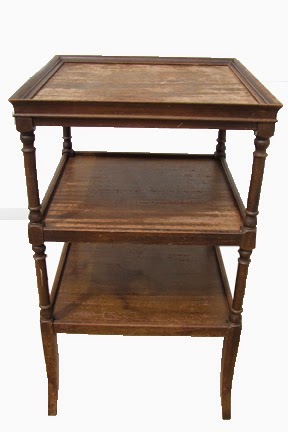 |
| End Table Before |
Leather on an end table such as this was commonly used for furniture as a decorative effect for the top. It worked nicely when new, but over the years these tables' leather got pretty beat up. Scratches, gouges, tears and discoloration became more common than shiny new leather and it no longer looked pretty, just old and worn out.
 |
| End Table After |
While I wasn't quite sure what I would do to replace the leather which was peeling up on one side, it needed to be completely removed, which had proven to be quite a task, as the non-lifted portion adhered quite well. I had to use a small heat gun to soften the adhesive enough to carefully slip my putty knife under the leather and slowly peel it off the wood. It took about 30 minutes, but I was successfully able to lift the last corner of the leather and tear it off.
Goodbye old leather, hello new design.
I used a chisel to scrape remaining paper left by the leather section, then sanded the surface smooth. While I was unsure exactly what I would do to replace the leather, I knew that when the time came, I'd have exactly the right treatment, so I got to work on the rest of it. I stripped, sanded and stained the end table using cherry stain, which brought out the gorgeous tones in the cherry wood the table was made from. Making a decision on stain can be tricky, since you don't really know how it will look until you apply it. A darker stain would have hidden much of the wood grain, so cherry was the perfect choice for this end table.
Once stained, I put this table aside while working on other furniture items for this project, (while my I left my subconscious work on the creative side of how to make the top stand out). Eventually I had formulated an idea which involved my trusty carpenter, my husband Jim. I had asked him to make custom veneer sections out of oak and mahogany, so he sliced up sixteen 1-1/2" sections of veneer, more than enough to experiment with a workable design for the tabletop.
 |
| End Table After |
Using the freshly cut veneer sections, I laid out the pieces and worked up a design, much like one would put together a puzzle, only you create the design as you go. It took a while as I played around with the length of each piece, layout and design, but eventually I had created a random pattern I was satisfied with, then applied adhesive to the table and each veneer section, then let everything dry for fifteen minutes before I carefully positioned each section into place. There's no forgiveness when you work with adhesive cement on both sides of the wood. Once they're down, they're down, so it's a good idea to "dry fit" them before you apply the adhesive.
After sanding the tabletop to get all the veneer sections level, I applied golden pecan stain. Because of the two distinct woods, each wood had taken on a different tone, which created an interesting, artistic and contemporary tabletop. Once the stain was dry, I applied two coats of polyurethane to the lower areas and legs of the table and three coats to the top for added protection. It looked fabulous! This was definitely one of my favorite projects as I was able to blend the craft of refinishing, with the art of creating a custom made veneer design that gave this old beauty a modern, updated look.
This table was one of four pieces of furniture we did at the same time. Click on the links below to see the others:
http://finalefurniture.blogspot.com/2017/04/antique-secretary.html
http://finalefurniture.blogspot.com/2017/04/antique-writing-desk.html
http://finalefurniture.blogspot.com/2017/04/antique-piano-bench.html





































